
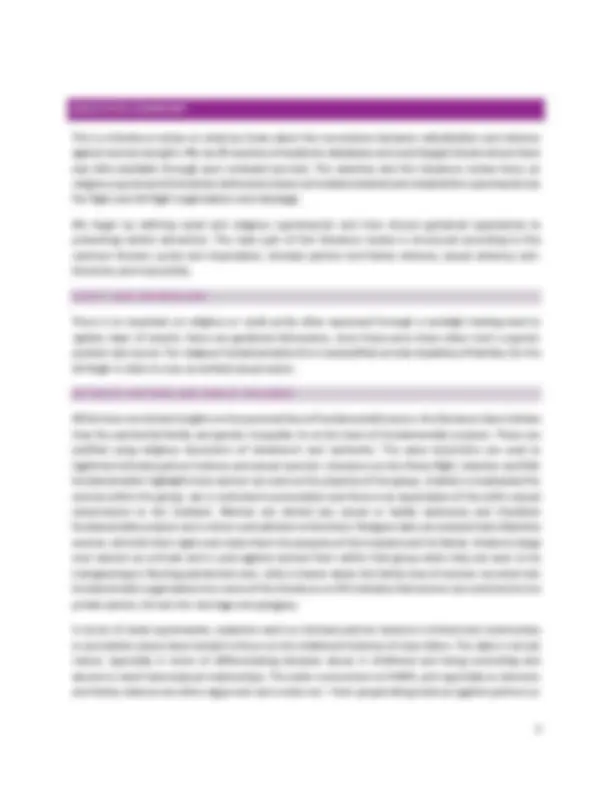
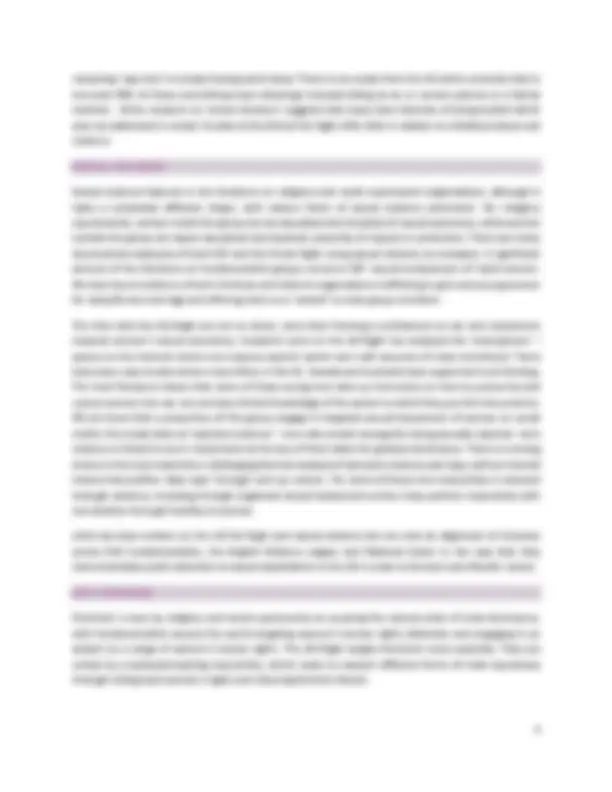

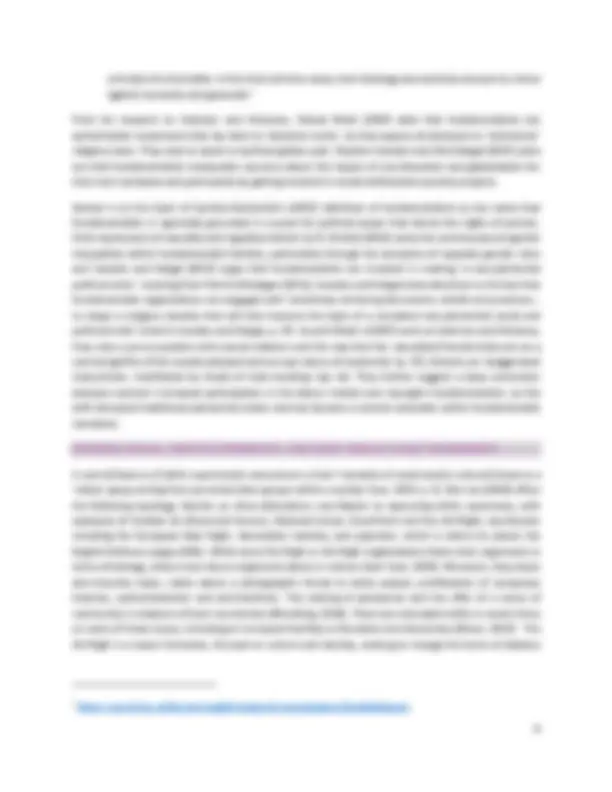

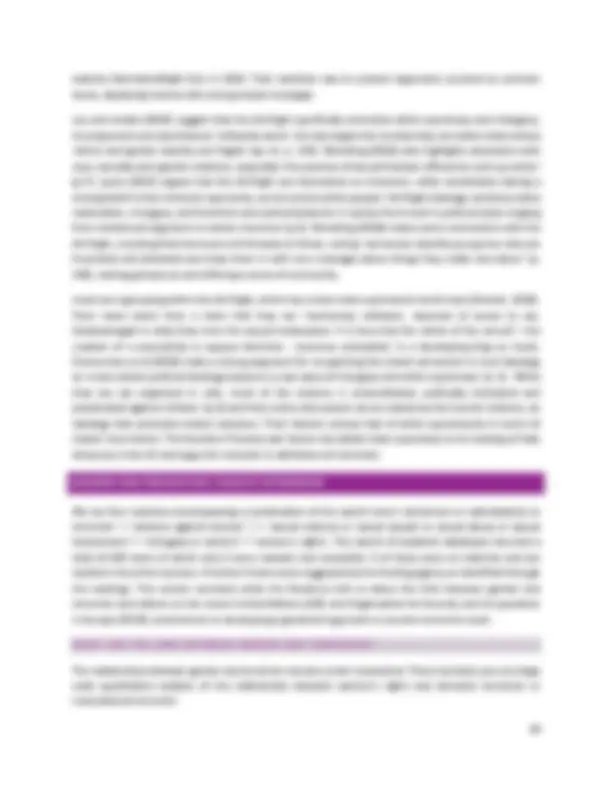
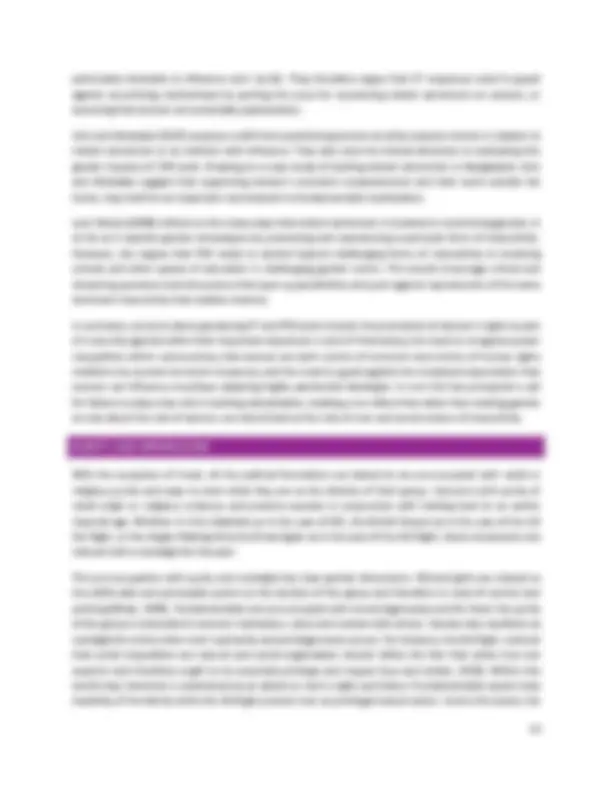
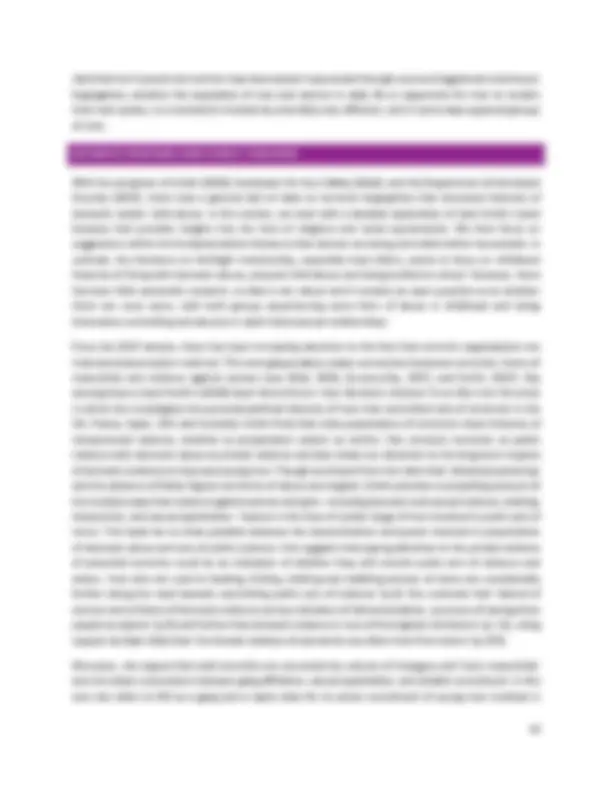
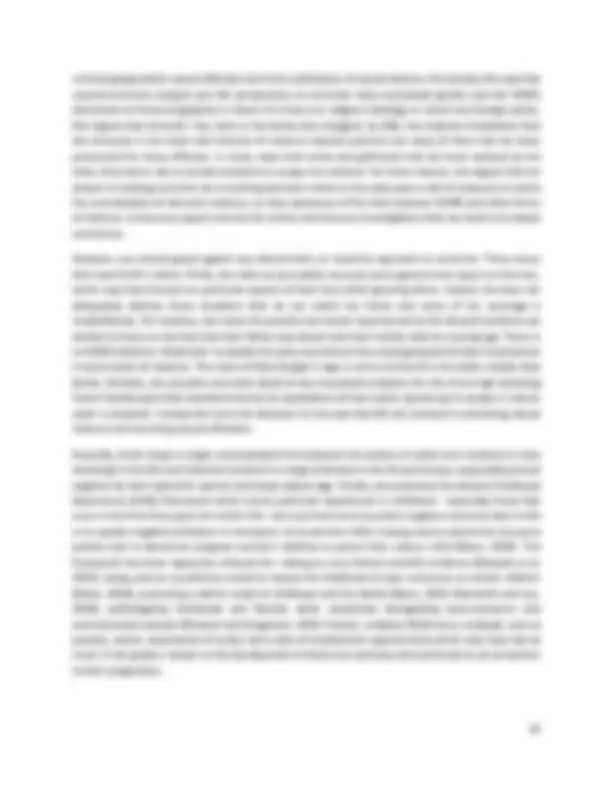
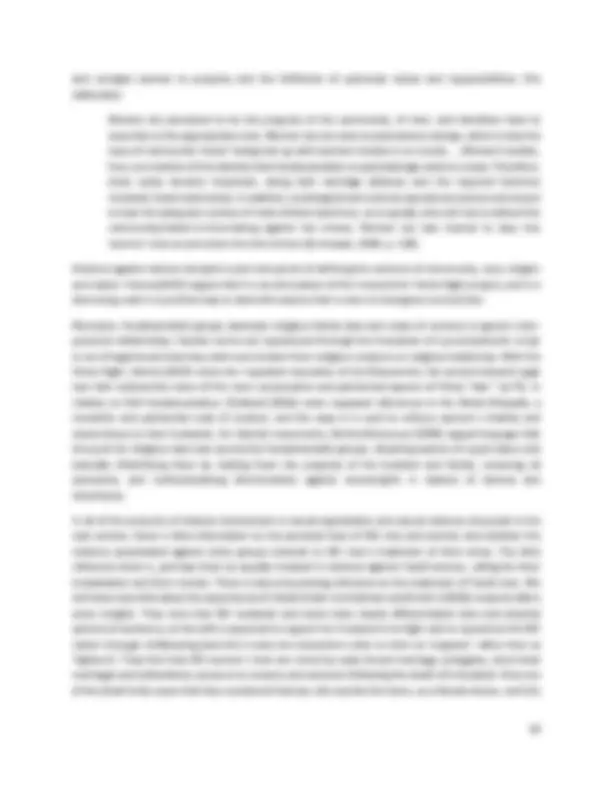
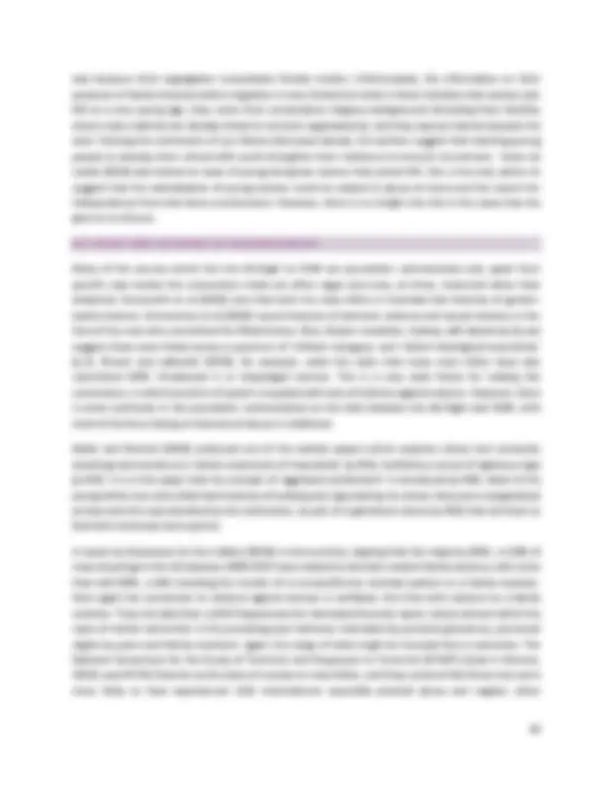
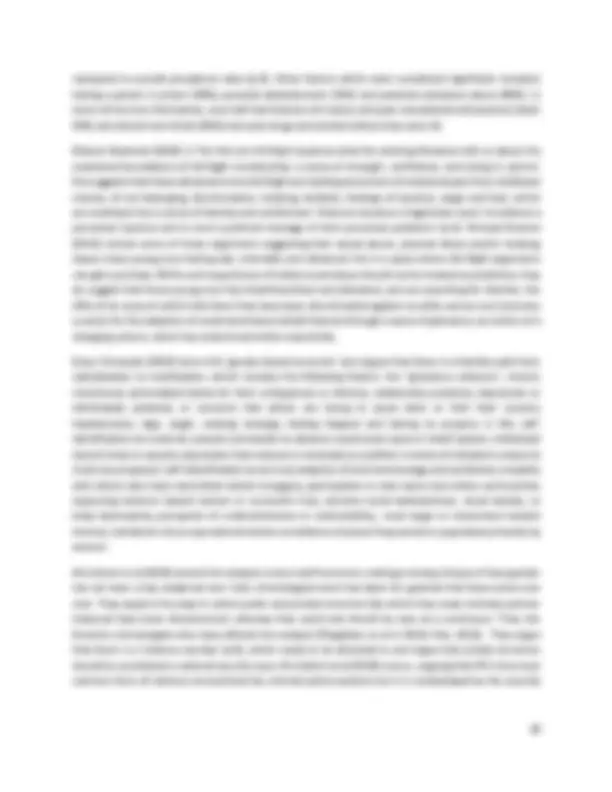
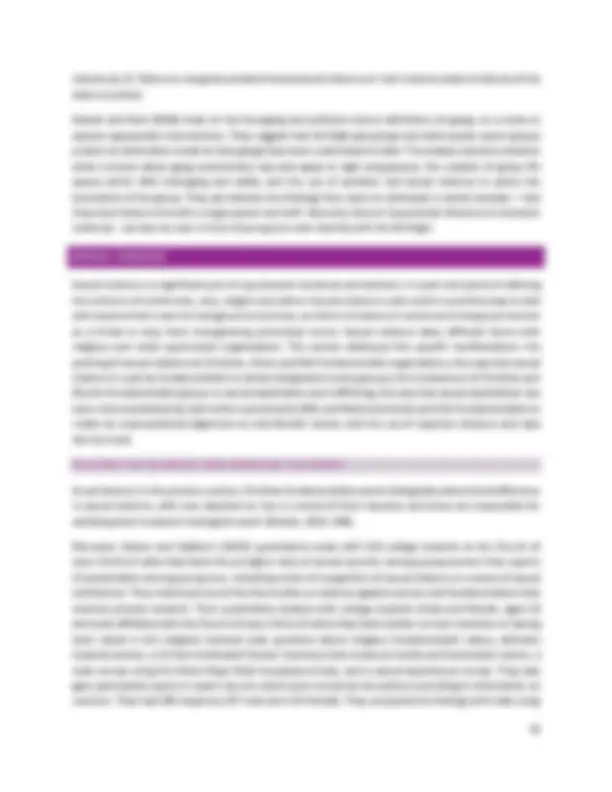
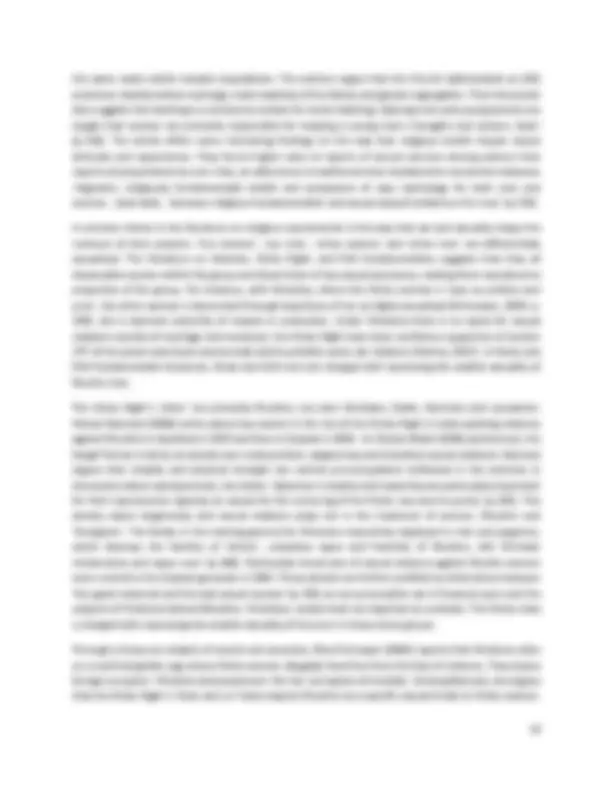
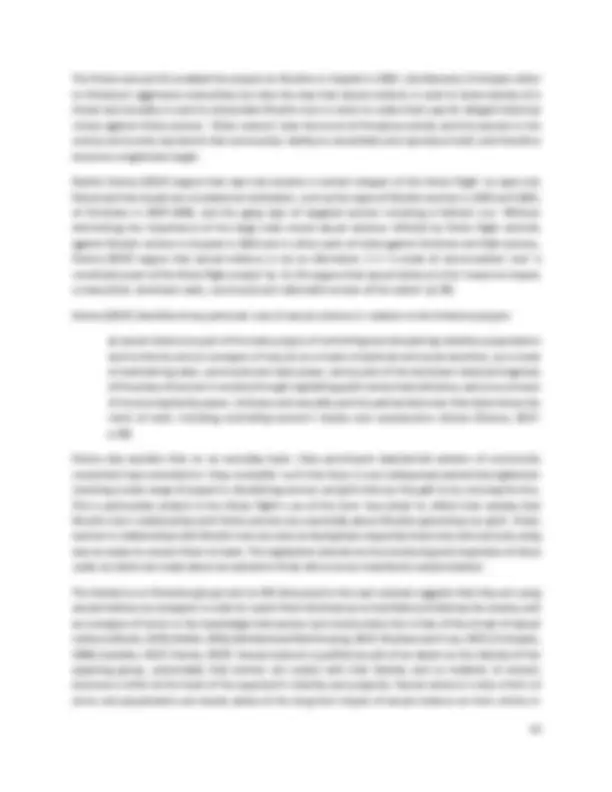
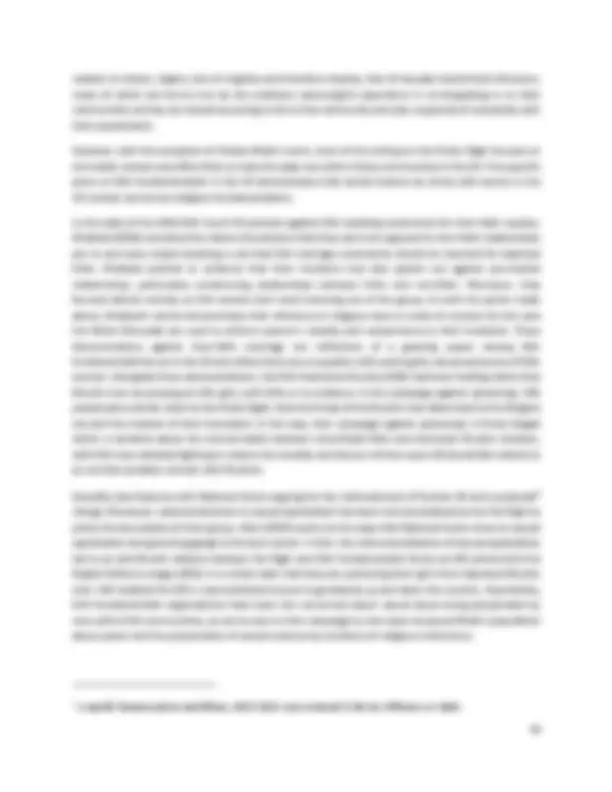
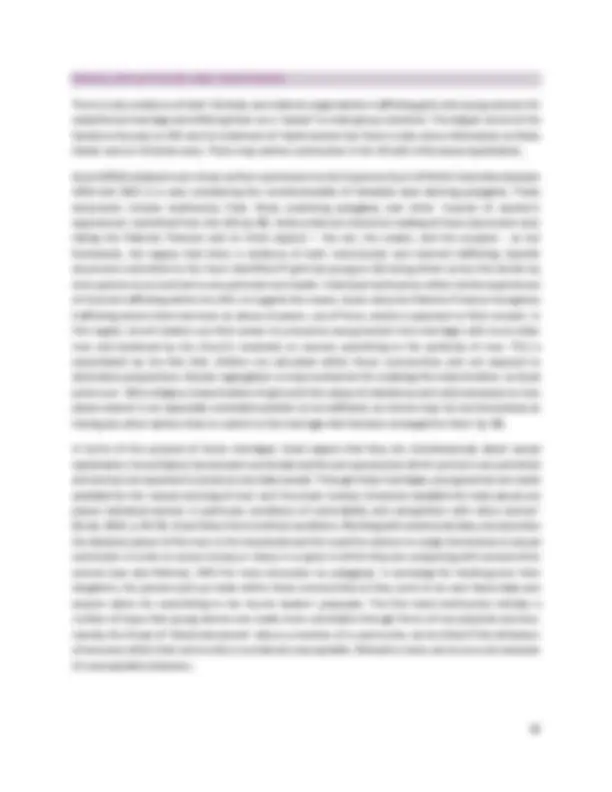
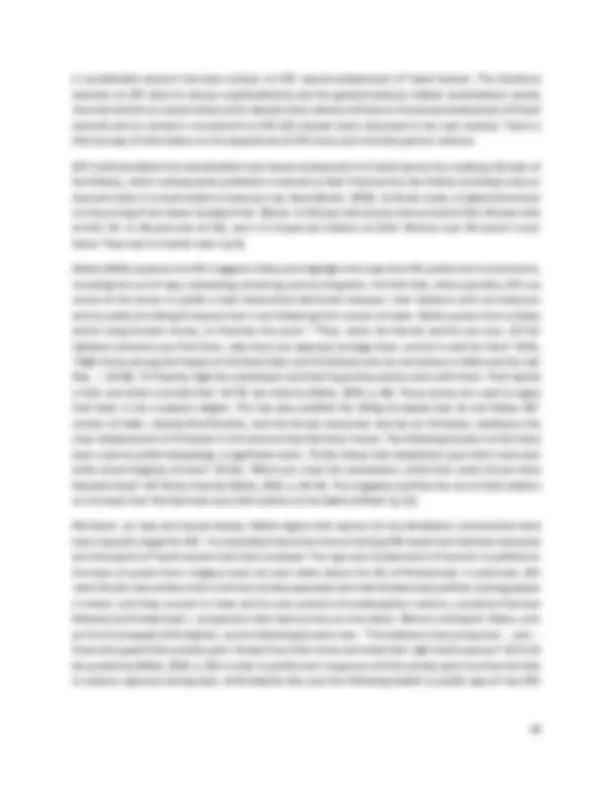
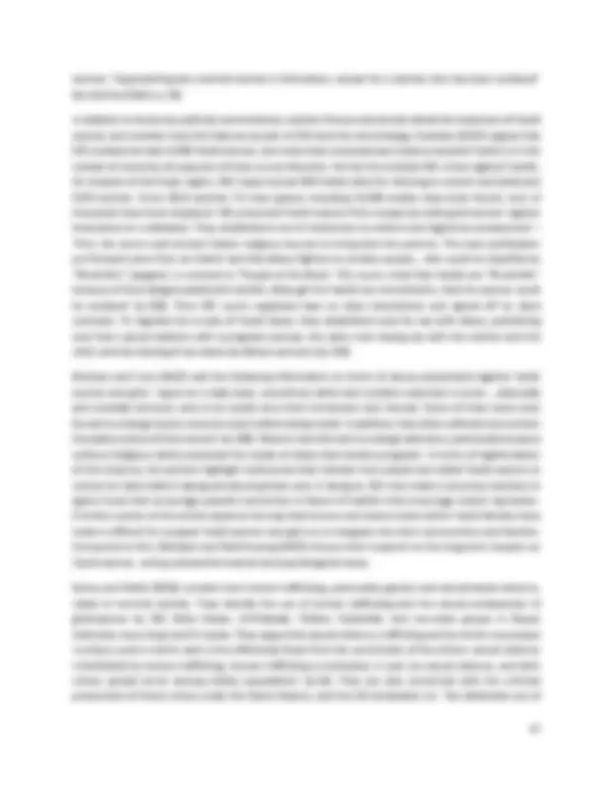
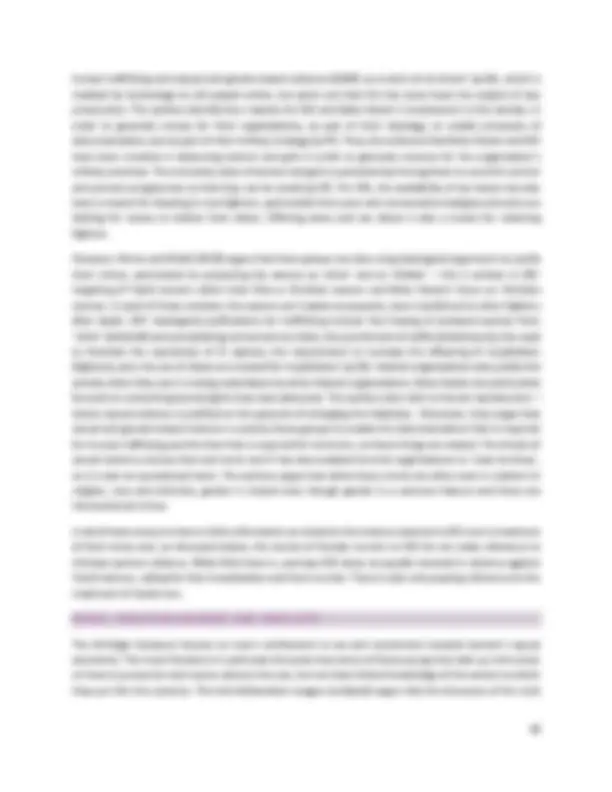
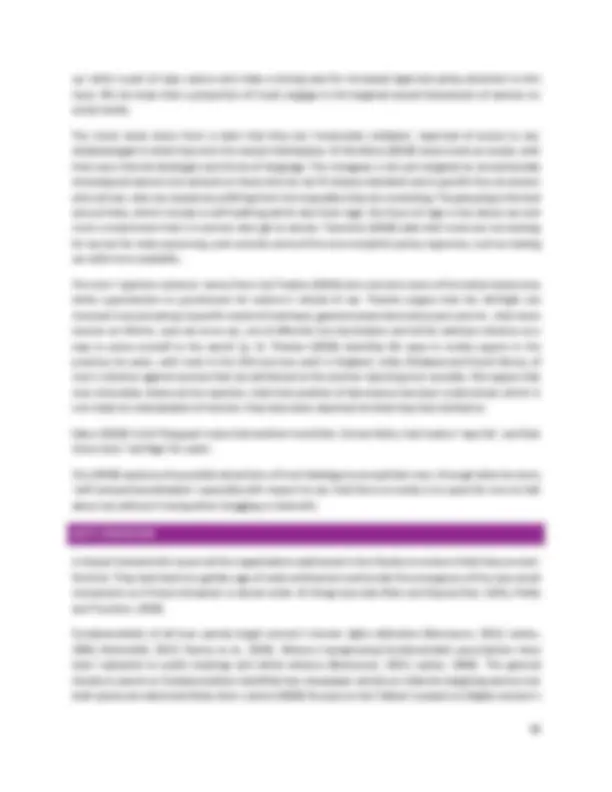
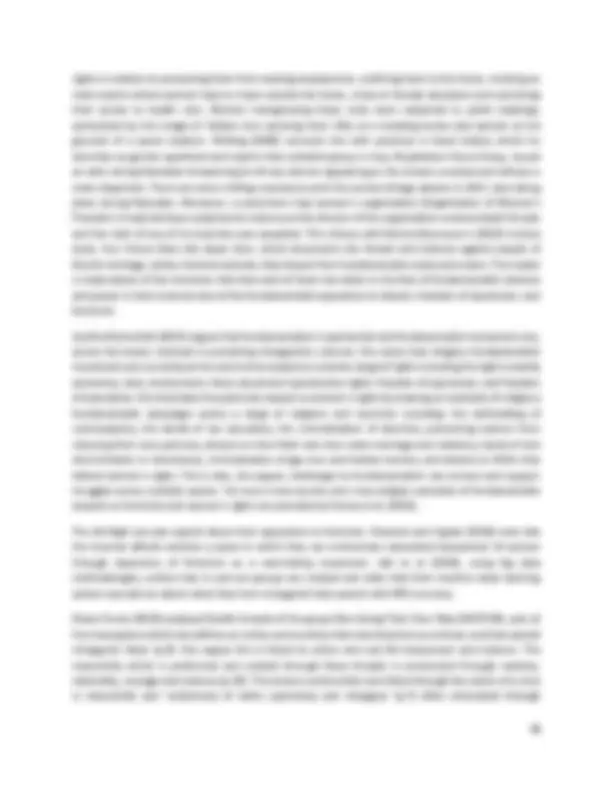
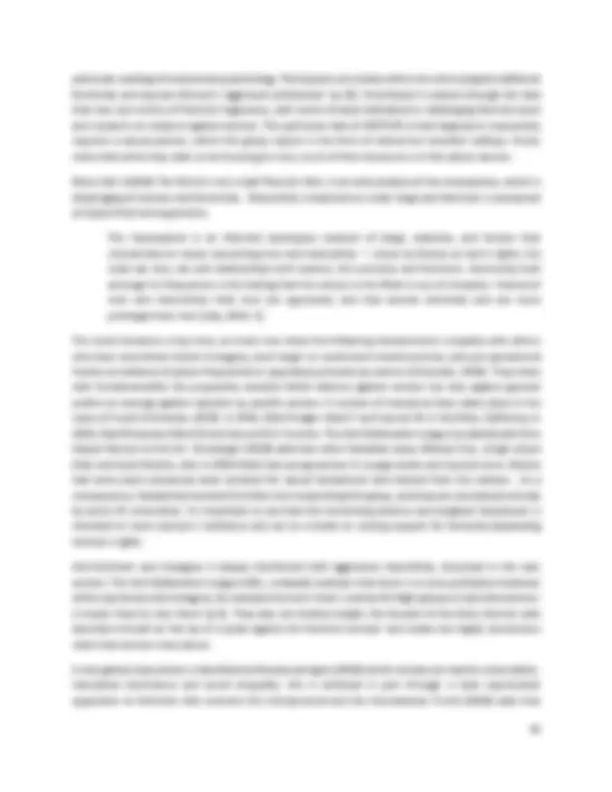
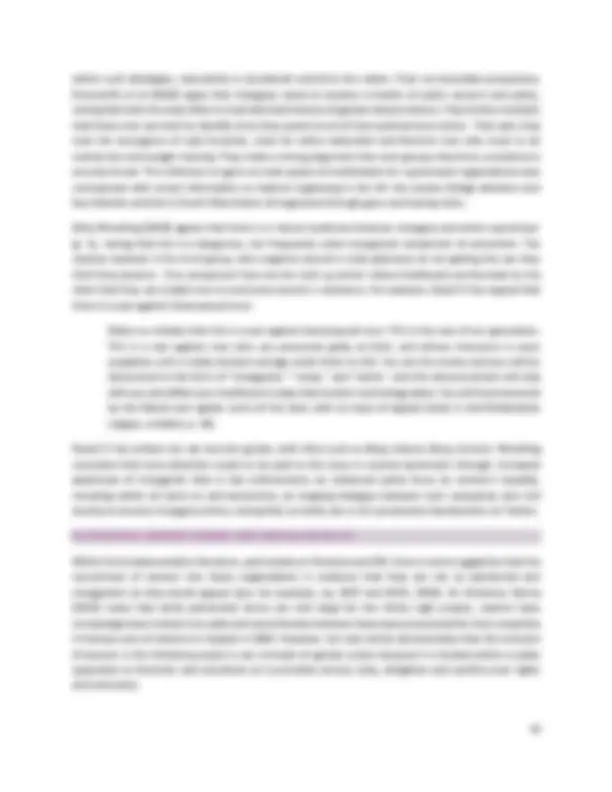
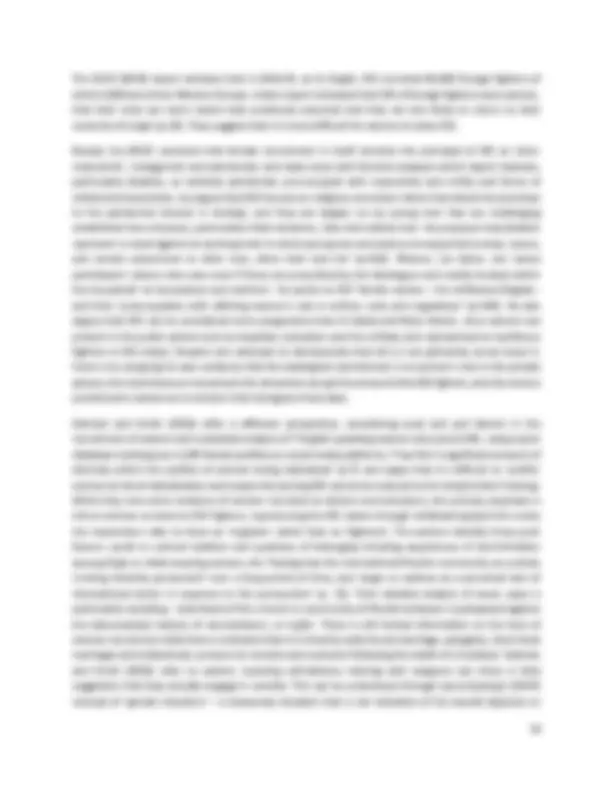

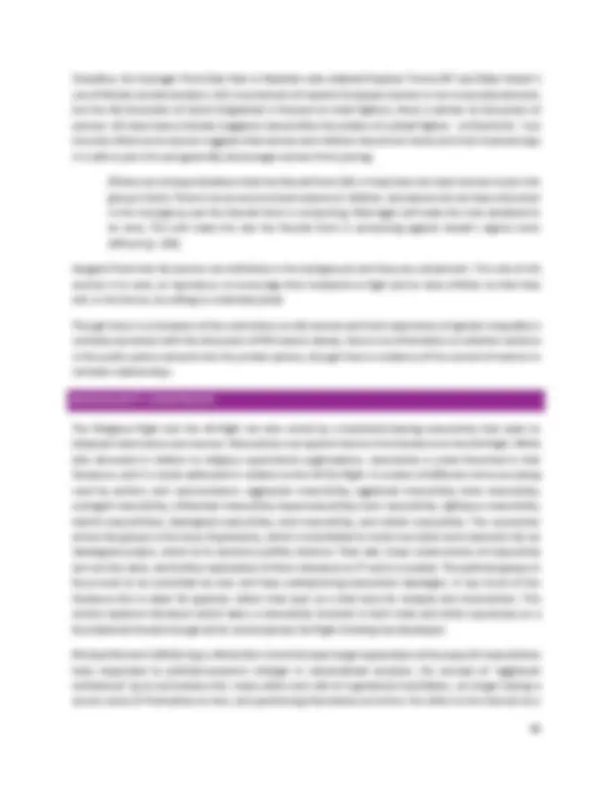
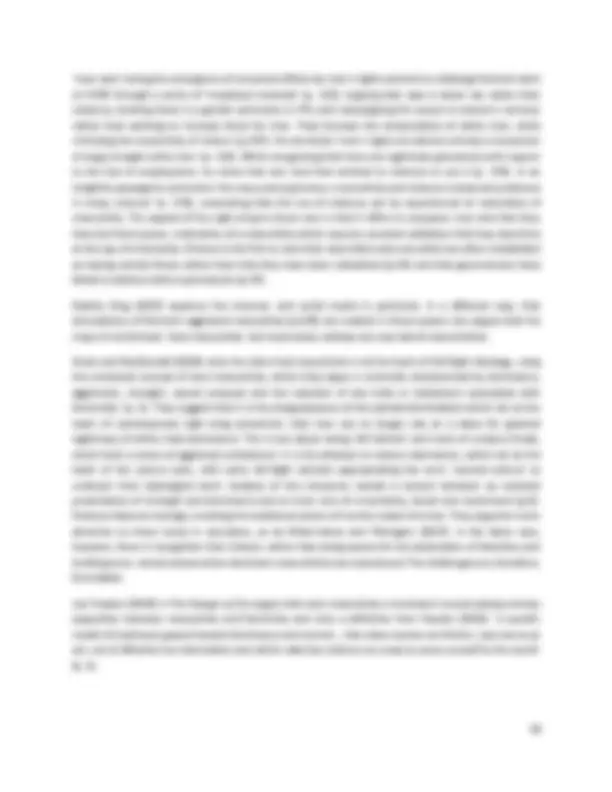
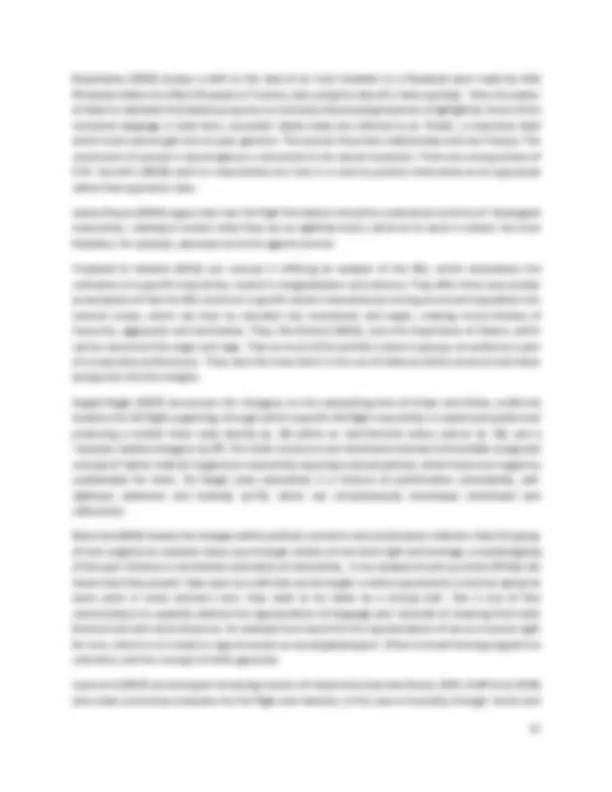
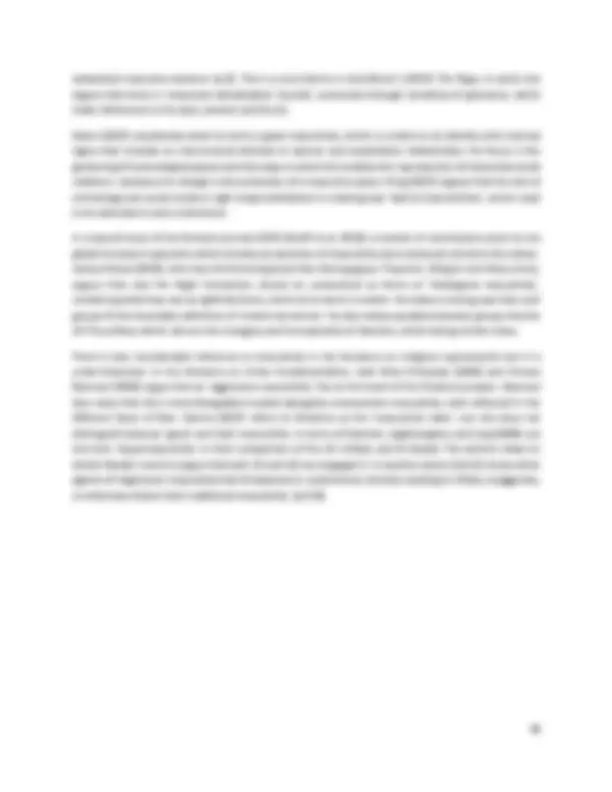
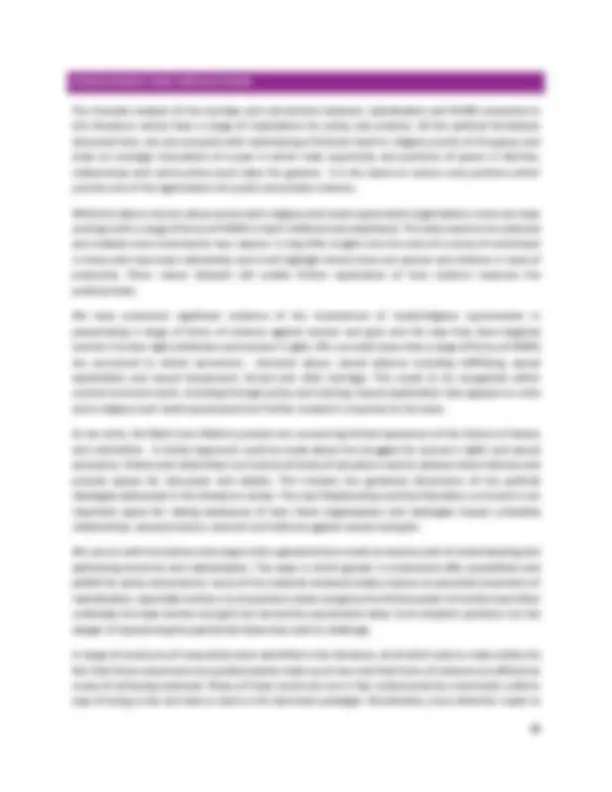

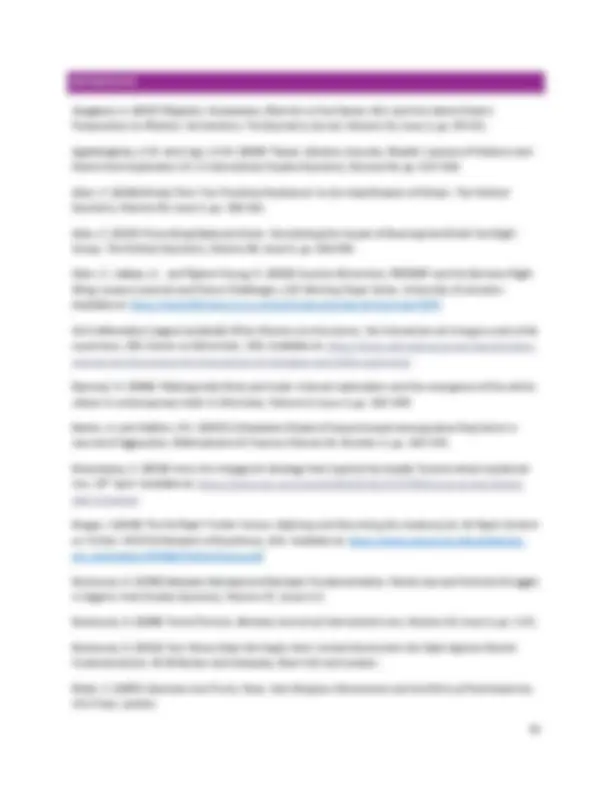

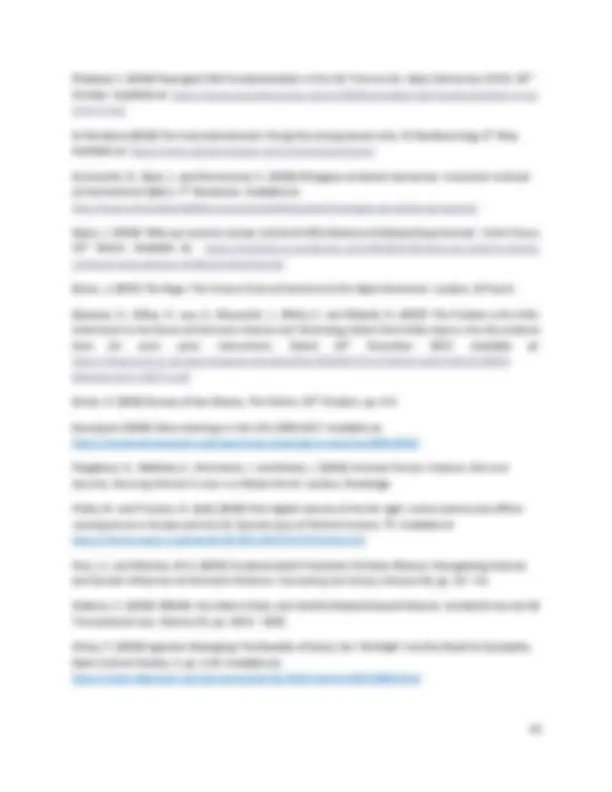
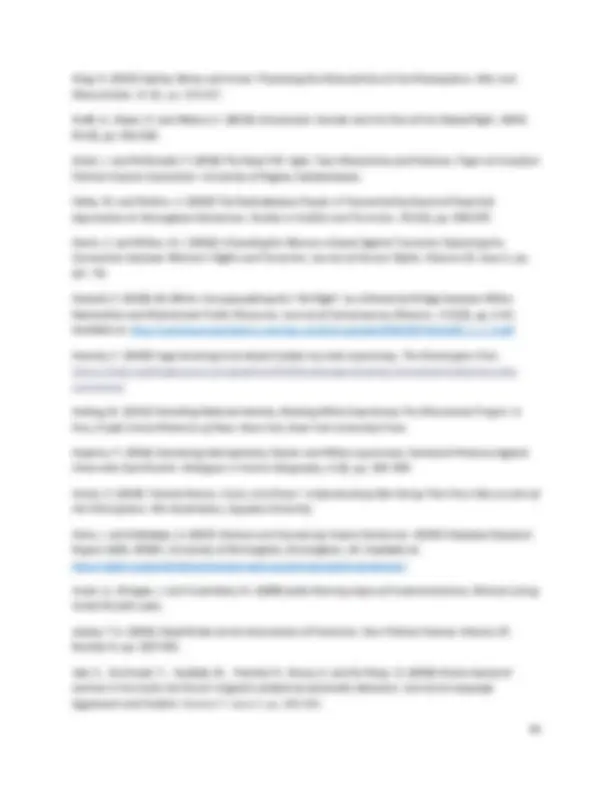
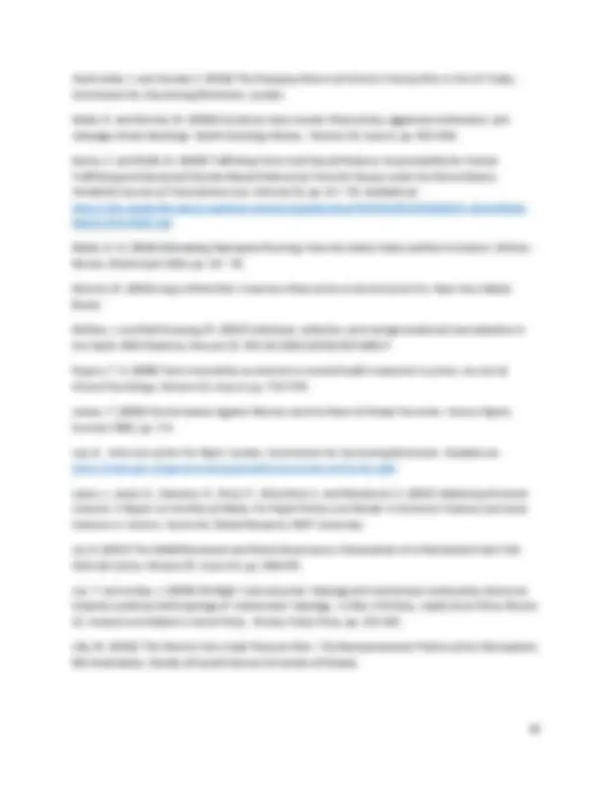


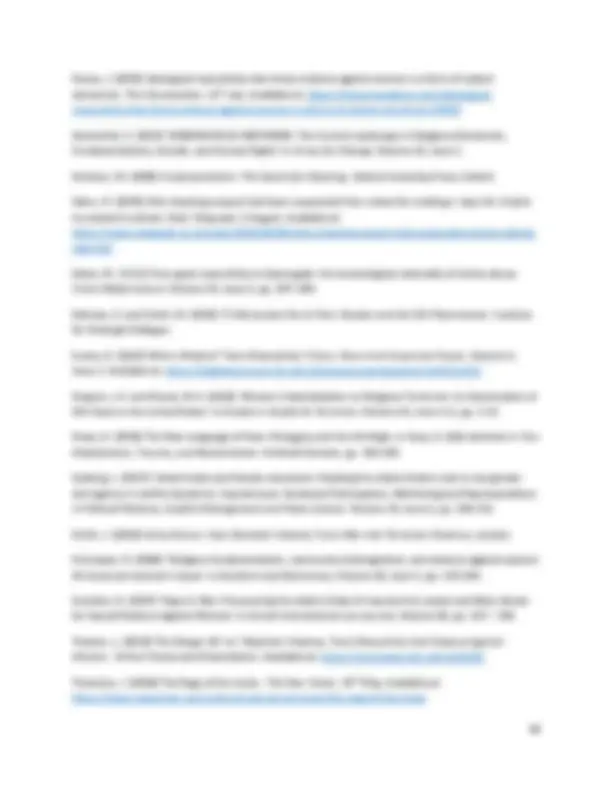



Study with the several resources on Docsity

Earn points by helping other students or get them with a premium plan


Prepare for your exams
Study with the several resources on Docsity

Earn points to download
Earn points by helping other students or get them with a premium plan
Community
Ask the community for help and clear up your study doubts
Discover the best universities in your country according to Docsity users
Free resources
Download our free guides on studying techniques, anxiety management strategies, and thesis advice from Docsity tutors
This is a literature review on what we know about the connections between radicalisation and violence against women and girls.
Typology: Study notes
1 / 49

This page cannot be seen from the preview
Don't miss anything!










































June 20 20
compiling ‘rape lists’ to simply having sexist ideas. There is one study from the US which contends that in one year 84% of those committing mass shootings included killing an ex or current partner or a family member. Other research on ‘school shooters’ suggests that many have histories of being bullied which was not addressed in school. Studies of the British Far Right offer little in relation to childhood abuse and violence. SEXUAL VIOLENCE Sexual violence features in the literature on religious and racial supremacist organisations, although it takes a somewhat different shape, with various forms of sexual violence prominent. For religious supremacists, women inside the group are de-sexualised and divested of sexual autonomy, while women outside the group are hyper-sexualised and deemed unworthy of respect or protection. There are many documented examples of both ISIS and the Hindu Right using sexual violence as a weapon. A significant amount of the literature on fundamentalist groups concerns ISIS’ sexual enslavement of Yezidi women. We also found evidence of both Christian and Islamist organisations trafficking in girls and young women for early/forced marriage and offering them as a ‘reward’ to male group members. The links with the Alt-Right are not so direct, since their framing is entitlement to sex and resentment towards women’s sexual autonomy. Academic work on the Alt-Right has analysed the ‘manosphere’ – spaces on the internet where men express explicit sexism and craft accounts of male victimhood. There have been case studies where mass killers in the US, Canada and Australia have supported Incel thinking. The Incel literature shows that some of these young men take up instruction on how to pressurise and coerce women into sex, but we have limited knowledge of the extent to which they put this into practice. We do know that a proportion of this group engage in targeted sexual harassment of women on social media. One study looks at ‘rejection violence’ – men who wreak revenge for being sexually rejected - here violence is linked to men’s resentment at the loss of their taken for granted dominance. There is a strong theme in the Incel material on challenging feminist analysis of domestic violence and rape; with an internal theme that justifies ‘date rape’ through ‘pick up culture’. For some of these men masculinity is restored through violence, including through organised sexual harassment online: they perform masculinity with one another through hostility to women. Little has been written on the UK Far Right and sexual violence but we note an alignment of interests across Sikh fundamentalists, the English Defence League and National Action in the way that they instrumentalise public attention to sexual exploitation in the UK in order to ferment anti-Muslim racism. ANTI-FEMINISM Feminism is seen by religious and racial supremacists as usurping the natural order of male dominance, with fundamentalists around the world targeting women’s human rights defenders and engaging in an assault on a range of women’s human rights. The Alt-Right targets feminism more explicitly. They are united by a backward-looking masculinity, which seeks to reassert different forms of male supremacy through rolling back women’s rights and silencing feminist dissent.
There is a shared sense of aggrieved masculinity in which the use of violence is seen to restore power and influence. Within the literature a series of masculinity constructs have been associated with forms of religious and racial supremacy: aggressive masculinity; aggrieved masculinity; beta masculinity; outraged masculinity; militarised masculinity; hypermasculinity; toxic masculinity; righteous masculinity; hybrid masculinities; ideological masculinity; nerd masculinity; and violent masculinity. These are not synonymous and deserve further attention to unpick how relevant they are to violent extremism.
theorised the connection between that supremacist organisation (or terrorism in general) and VAWG, and to draw out any specific deployment of concepts like masculinity, gender, misogyny, and patriarchy. This review is a thematic analysis of that literature. We begin with an introduction to the two strands of supremacism that we investigated – religious supremacism (or fundamentalism) and racial supremacism (or the Alt-Right and Far Right). We discuss the more generic literature on gender and terrorism and then we hone in on five key themes that cut across the literature on religious and racial supremacism: purity and imperialism; intimate partner and family violence; sexual violence; anti-feminism; and masculinity. DEFINING RELIGIOUS SUPREMACIST OR FUNDAMENTALIST MOVEMENTS The literature on religious fundamentalist groups and ideologies has grown since the 1970s, particularly since the emergence of a theocratic state in Iran, and there has been an exponential increase since 9/11. Across much of this literature, there is no uniform definition of fundamentalism as some writers use the term to describe orthodox religious practice and introverted communities rather than political movements interested in galvanising power. As a starting point, however, Torkel Brekke (2012) argues religious fundamentalists are modern movements but their primary objective is to re-instate clerical power and religious authority. Many writers on fundamentalism recognise the centrality of women and girls to fundamentalist projects, which share a pre-occupation with controlling women, their mobility, their bodies, their sexual relations and minds (see Bhatt, 1997; Imam et al., 2004; Ruthven, 2004; Brekke, 2012; Cowden and Sahgal, 2017). Moreover, when literature searches combine the terms ‘fundamentalism’ + ‘gender’ + ‘violence against women’ + ‘women’s rights’ there is a distinct confluence in the way that their interest in women is theorised. As a baseline, we use the following definition, originally developed by Women Against Fundamentalism and extended by Feminist Dissent : By religious fundamentalism we refer to modern religious-political interpretations of religious texts, which aim to create a social order based on a 'return to fundamentals' of an imaginary utopian past. The control of the minds and bodies of women and sexual minorities are central to this ideology. Fundamentalist movements want to impose their version of religion as the only valid one. They aim to reduce plural spaces and the right to interpret, dissent and doubt. They are often backed by violence or the threat of violence aimed at creating an atmosphere of terror. They are frequently flexible about the means they deploy and may seek to overthrow the existing order or make use of the institutions of the state such as parliament, the army, police and judiciary. They tend to use modern technologies and cultural and democratic spaces in order to establish and consolidate their power, whether in the community or the state. In many cases they make skilful use of the language of human rights while undermining fundamental rights and the
principle of universality. In the most extreme cases, their ideology and activities amount to crimes against humanity and genocide.^2 From his research on Islamism and Hindutva, Chetan Bhatt (1997) adds that fundamentalists are authoritarian movements that lay claim to ‘absolute truths’, as they oppose all attempts to ‘reinterpret’ religious texts. They seek to assert a mythical golden past. Stephen Cowden and Gita Sahgal (2017) point out that fundamentalists manipulate concerns about the impact of neo-liberalism and globalisation for their own narratives and particularly by getting involved in social welfare/anti-poverty projects. Gender is at the heart of Cynthia Rothschild’s (2017) definition of fundamentalism as she notes that fundamentalism is ‘generally grounded in a quest for political power that denies the rights of women, limits expressions of sexuality and regulates bodies’ (p.7). Brekke (2012) notes the central place of gender inequalities within fundamentalist families, particularly through the ascription of separate gender roles and Cowden and Sahgal (2017) argue that fundamentalists are invested in creating ‘a neo-patriarchal political order’. Quoting from Patricia Madigan (2011), Cowden and Sahgal draw attention to the fact that fundamentalist organisations are engaged with ‘selectively retrieving documents, beliefs and practices… to shape a religious identity that will then become the basis of a recreated neo-patriarchal social and political order’ (cited in Cowden and Sahgal, p. 17). As with Bhatt’s (1997) work on Islamism and Hindutva, they note a pre-occupation with sexual relations and the way that the ‘sexualised female body acts as a central signifier of the morally debased and corrupt nature of modernity’ (p. 17), linked to an ‘exaggerated masculinism, manifested by rituals of male bonding’ (op cit). They further suggest a deep connection between women’s increased participation in the labour market and resurgent fundamentalism, as this shift disrupted traditional patriarchal orders and has become a central complaint within fundamentalist narratives. DEFINING RACIAL / WHITE SUPREMACIST, FAR RIGHT AND ALT-RIGHT MOVEMENTS A central feature of white supremacist movements is their ‘narrative of racial and/or cultural threat to a ‘native’ group arising from perceived alien groups within a society’ (Lee, 2019: p. 1). Ben Lee (2019) offers the following typology: fascism as ultra-nationalism; neo-Nazism as espousing white supremacy, with examples of Combat 18, Blood and Honour, National Action, Stormfront and the Alt-Right; neo-fascism including the European New Right, Generation Identity; and populism, which is where he places the English Defence League (EDL). While some Far Right or Alt-Right organisations frame their arguments in terms of biology, others now rely on arguments about a ‘culture clash’ (Lee, 2019). Moreover, they share anti-minority views, claims about a demographic threat to white people, proliferation of conspiracy theories, authoritarianism and anti-Semitism. The stoking of grievances and the offer of a sense of community is a feature of their recruitment (Wendling, 2018). There are noticeable shifts in recent times on some of these issues, including an increased hostility to liberalism and democracy (Ebner, 2017). The Alt-Right is a newer formation, focused on culture and identity, seeking to change the terms of debates (^2) https://warwick.ac.uk/fac/arts/english/research/currentprojects/feministdissent/
website AlternativeRight.Com in 2010. Their ambition was to present arguments couched as common sense, deploying memes with strong simple messages. Lux and Jordan (2019) suggest that the Alt-Right specifically enmeshes white supremacy and misogyny, its proponents are described as ‘militantly sexist’, the key targets for membership are white males whose ‘ethnic and gender identity are fragile’ (op cit, p. 153). Wendling (2018) also highlights obsessions with race, sexuality and gender relations, especially ‘the promise of sexual freedom offered by ‘pick up artists’ (p.7). Lyons (2017) argues that the Alt-Right see themselves as irreverent, while nonetheless having a strong belief in their inherent superiority, as men and as white people: ‘Alt-Right ideology combines white nationalism, misogyny, anti-Semitism and authoritarianism in various forms and in political styles ranging from intellectual argument to violent invective’ (p.2). Wendling (2018) makes some connections with the Alt-Right, including that there were UK threads on 4chan, noting: ‘extremists identify young men who are frustrated and alienated and draw them in with core messages about things they really care about’ (p. 1 92), stoking grievances and offering a sense of community. Incels are a grouping within the Alt-Right, which has a clear male supremacist world view (Chokshi, 2018). Their name stems from a claim that they are ‘involuntary celibates’, deprived of access to sex, disadvantaged in what they term the sexual marketplace. It is here that the notion of the red pill – the creation of a masculinity to oppose feminism - becomes embedded. In a developing blog on Incels, Zimmerman et al (2018) make a strong argument for recognising the violent extremism in Incel ideology as ‘a new violent political ideology based on a new wave of misogyny and white supremacy’ (p. 1). While they are not organised in cells, much of the violence is ‘premeditated, politically motivated and perpetrated against civilians’ (p.2) and their online discussions can be viewed as the fuse for violence, an ideology that promotes violent solutions. Their rhetoric echoes that of white supremacists in terms of violent insurrection. The Southern Poverty Law Centre has added male supremacy to its tracking of hate discourse in the US and argue for inclusion in definitions of terrorism. GENDER AND PREVENTING VIOLENT EXTREMISM We ran four searches encompassing a combination of the search terms ‘extremism or radicalisation or terrorism’ + ‘violence against women’ / + ‘sexual violence or sexual assault or sexual abuse or sexual harassment’/ + ‘misogyny or sexism’/ + ‘women’s rights’. The search of academic databases returned a total of 609 items of which only 5 were relevant and accessible. 4 of these were on Islamism and are tackled in the other sections. A further 4 items were suggested by the funding agency or identified through the readings. This section considers what the literature tells us about the links between gender and terrorism and reflects on the recent United Nations (UN) and Organisation for Security and Co-operation in Europe (OSCE) commitment to developing a gendered approach to counter-terrorism work. WHAT ARE THE LINKS BETWEEN GENDER AND TERRORISM? The relationship between gender and terrorism remains under researched. There has been just one large scale quantitative analysis of the relationship between women’s rights and domestic terrorism or transnational terrorism.
Harris and Milton (2016) attempted to test the relationship between gender and terrorism through a quantitative analysis involving a time-series cross-sectional dataset covering domestic terrorism, transnational terrorism and women’s rights across 150 countries from 1979 to 2004. They investigated the hypothesis that ‘when women’s rights increase, the increased involvement of women in a country serves as a brake on the radicalisation process… [but also]… as women have more opportunities, there is less reason for them to engage in political violence’ (p.61). They refer to women as potential ‘veto players’ that can ameliorate the rise of terrorism. Bearing in mind that the time frame of this study precedes ISIS, the authors extracted the following information from three datasets: the number of domestic terrorist attacks within a country (using the Global Terrorism Database); the nationality of individuals committing transnational terrorist attacks from a country (International Terrorism: Attributes of Terror Events dataset); and measurements for three categories of women’s rights – economic, political and social rights (from the Cingranelli-Richards (CIRI) Human Rights dataset). They found a negative relationship between women’s rights and domestic terrorism but no significant relationship between women’s rights and transnational terrorism (i.e. where an individual travels abroad to engage in terrorist acts), suggesting transnational terrorist activity may be more related to foreign regimes and the rights of particular groups of people. Conversely, it’s equally possible that the increase in terrorism is a direct response to the increase in formal gender equality, such as women’s entry into paid employment, access to education, the right to vote and become political representatives. GENDERING COUNTER-TERRORISM AND PREVENTING VIOLENT EXTREMISM WORK Recent years have seen increased attention to a gendered approach to counter-terrorism (CT) and preventing violent extremism (PVE) work. The UN Security Council passed resolution 2242 in 2015 calling for ‘greater integration by States of their agendas on women, peace and security’ including on CT and PVE (OSCE, 2019, p. 12). This was followed by the UN Secretary General’s Plan of Action, which places importance on women’s role in preventing violent extremism. The UN resolution was adopted by the OSCE. The OSCE recently released a Handbook (2019) urging governments to implement a gendered approach by: involving women at every level of counter-terrorism work; identifying gendered strategies in terrorist recruitment (such as the way women are offered ‘sisterhood’ in response to their issues of belonging while the appeal to men is based on wealth and sexual gratification and a return to former male power); by analysing terrorist organisations through a gendered lens (such as by noting gender differences in victimisation and the gender dimensions of ideologies); and the different roles played by men and women within the organisations. Through her study of gender and US counter-terrorism, Joana Cook (2019) argues that understandings of terrorist organisations necessarily inform the response to these organisations. It follows that a lack of understanding of the gendered practices and impacts of terrorist organisations will lead to flawed state responses to terrorism. By way of example, she notes that when women have not been visible on the front lines of terrorist organisations, particularly as fighters, their participation has tended to be overlooked and states have failed to respond to or prevent their recruitment. Yet in May 2020, women and children comprised 10,000 residents in the camps around Iraq and Syria, they have borne children
particularly desirable to influence sons’ (p.61). They therefore argue that CT responses need to guard against securitising motherhood by putting the onus for countering violent extremism on women, or assuming that women are essentially peacemakers. Idris and Abdelaziz (2017) propose a shift from positioning women as either passive victims in relation to violent extremism or as mothers with influence. They also note the limited attention to evaluating the gender impacts of CVE work. Drawing on a case study of tackling violent extremism in Bangladesh, Idris and Abdelaziz suggest that supporting women’s economic empowerment and their work outside the home, may itself be an important counterpoint to fundamentalist mobilisation. Lynn Davies (2008) reflects on the many ways that violent extremism is involved in constricting gender, in so far as it exploits gender stereotypes by promoting and reproducing a particular form of masculinity. However, she argues that PVE needs to extend beyond challenging forms of masculinity to involving schools and other spaces of education in challenging gender norms. This would encourage critical and dissenting questions and discussions that open up possibilities and push against reproduction of the same dominant masculinity that enables violence. In summary, concerns about gendering CT and PVE work include: the promotion of women’s rights as part of a security agenda rather than important objectives in and of themselves; the need to recognise power inequalities within communities; that women are both victims of terrorism and victims of human rights violations by counter-terrorism measures; and the need to guard against the misplaced expectation that women can influence men/boys adopting highly patriarchal ideologies. In turn this has prompted a call for fathers to play a key role in tackling radicalisation, leading us to reflect that rather than reading gender as only about the role of women, we should look at the role of men and constructions of masculinity. PURITY AND IMPERIALISM With the exception of Incels, all the political formations we looked at are pre-occupied with racial or religious purity and ways to stem what they see as the dilution of their group. Concerns with purity of racial origin or religious scripture and practice operate in conjunction with harking back to an earlier imperial age. Whether it’s the Caliphate as in the case of ISIS, the British Empire as in the case of the UK Far Right, or the slogan Making America Great Again as in the case of the Alt-Right, these movements are imbued with a nostalgia for the past. This pre-occupation with purity and nostalgia has clear gender dimensions. Women/girls are viewed as the defile-able and permeable points on the borders of the group and therefore in need of control and policing (Bhatt, 1996). Fundamentalists are pre-occupied with moral degeneracy and for them the purity of the group is embodied in women’s behaviour, dress and contact with others. Gender also manifests as nostalgia for a time when men’s authority and privileges were secure. For instance, the Alt-Right, contend that social inequalities are natural and social organisation should reflect the fact that white men are superior and therefore ought to be accorded privilege and respect (Lux and Jordan, 2019). Within this world view, feminism is understood as an attack on men’s rights and status. Fundamentalists assert male headship of the family while the Alt-Right present men as privileged sexual actors. Across the board, the
idea that men’s power and control may have waned is expressed through a sense of aggrieved victimhood. Segregation, whether the separation of men and women in daily life or arguments for men to reclaim their own spaces, is a mechanism invoked by ostensibly very different, and in some ways opposed groups of men. INTIMATE PARTNER AND FAMILY VIOLENCE With the exception of Smith (2019), Everytown for Gun Safety (2018), and the Department of Homeland Security (2017), there was a general lack of data on terrorist biographies that discussed histories of domestic and/or child abuse. In this section, we start with a detailed exploration of Joan Smith’s book because that provides insights into the lives of religious and racial supremacists. We then focus on suggestions within the fundamentalism literature that women are being controlled within households. In contrast, the literature on Alt-Right membership, especially mass killers, seems to focus on childhood histories of living with domestic abuse, physical child abuse and being bullied at school. However, there has been little systematic research, so data is not robust and it remains an open question as to whether there are cross overs, with both groups experiencing some form of abuse in childhood and being themselves controlling and abusive in adult heterosexual relationships. Since the 2017 attacks, there has been increasing attention to the fact that terrorist organisations are male dominated and/or male led. This emerging analysis makes connections between terrorism, forms of masculinity and violence against women (see Afzal, 2018; Gurumurthy, 2017; and Smith, 2017). Key among these is Joan Smith’s (2019) book Home Grown: How Domestic Violence Turns Men into Terrorists in which she investigates the personal-political histories of men that committed acts of terrorism in the UK, France, Spain, USA and Australia. Smith finds that male perpetrators of terrorism share histories of interpersonal violence, whether as perpetrators and/or as victims. She connects terrorism as public violence with domestic abuse as private violence and also draws our attention to the long-term impacts of domestic violence on boys and young men. Though we dissent from her claim that ‘detached parenting’ and the absence of father figures are forms of abuse and neglect, Smith provides a compelling account of the multiple ways that violence against women and girls - including domestic and sexual violence, stalking, harassment, and sexual exploitation - feature in the lives of a wide range of men involved in public acts of terror. This leads her to draw parallels between the desensitisation and power involved in perpetration of domestic abuse and acts of public violence. She suggests that paying attention to the private violence of potential terrorists could be an indication of whether they will commit public acts of violence and states, ‘men who are used to beating, kicking, choking and stabbing women at home are considerably further along the road towards committing public acts of violence’ (p.6). She contends that ‘hatred of women and a history of domestic violence are key indicators of dehumanisation, a process of seeing other people as objects’ (p.9) and further that domestic violence is ‘one of the highest risk factors’ (p. 11), citing support by Nazir Afzal that ‘the female relatives of extremists are often their first victims’ (p.275). Moreover, she argues that male terrorists are connected by cultures of misogyny and ‘toxic masculinity’ and she draws connections between gang affiliation, sexual exploitation, and jihadist recruitment. In this vein she refers to ISIS as a gang and a rapist state for its active recruitment of young men involved in
Although Smith shines a spotlight on gender and violence in the private sphere, one could argue that gender becomes over-emphasised and other factors downplayed, such as religious conviction, opposition to dissident voices, experiences of racism and poverty, and foreign policy. In her account, terrorism is another form of men’s violence. As we show throughout this literature review, religious and racial supremacists are certainly engaged in discriminatory projects that seek to undermine and marginalise women/girls, but they are equally targeting male dissenters and secularists (the Bangladeshi bloggers is a case in point) and/or non-white men (as in the case of Darren Osborne, the Finsbury Park Mosque attacker). Smith’s analysis may not be able to explain the actions of Roshonara Chaudhry, for instance, a high achieving teenager so angered by the War on Terror that she stabbed her local MP Stephen Timms after lengthy engagement with fundamentalists online. Chaudhry then refused legal representation at trial because of her unwillingness to legitimise secular law or engage with anything but religious law. Moreover, the brutalisation of women is not evenly spread for Islamist organisations – there is a great deal of evidence of sex discrimination (and here Smith’s argument that ISIS is inherently misogynistic runs true) but there is little information on domestic abuse or intimate partner violence, rather the violence is directed at all (male and female) members of the other group. Of course, Smith could be right that this is because little attention has been paid to the private sphere. FUNDAMENTALIST FAMILIES AND MALE HEADSHIP With the exception of Joan Smith (2019), there is little detail on intimate partner violence or histories of abuse within the literature on fundamentalism and fundamentalist actors. Instead there is considerable discussion of the use of religion, religious laws and gender segregation to justify inequality within the family and to condone intimate partner violence. Torkel Brekke (2012) discusses male headship of the Christian fundamentalist family as the foundation for gender inequality within the household; women are expected to be nurturers while men are breadwinners and decision-makers. He explains how Christian fundamentalists use the story of genesis to argue that men and women were made differently: they draw on key passages from the New Testament ‘to legitimate what they believe are correct principles on which to build gender roles in everyday life. The two most prominent principles are difference and complementarity’ (p.239). Women are positioned as nurturing mothers concerned with the home while men are strong leaders and breadwinners. Moreover, they have different sexual instincts – referring to Evangelical sex manuals he explains that ‘men are generally thought to be less in control of their impulses and wives are responsible for satisfying their husband’s biological needs’ (p.240) and these differences are the basis of a good marriage. He also highlights the importance of ‘authority’ and ‘obedience’ in fundamentalist discourse. When fundamentalists acknowledge problems within marriages this is assumed to be a consequence of men failing to assert sufficient authority. Echoing some of Brekke’s points, Foss and Warnke (2003) make clear links between intimate partner violence and the gender roles that are invoked and supported by the religious community. They look at the experiences of domestic violence among Fundamentalist Protestant Christian (FPC) women in the USA and note that this is condoned by family structures, religious beliefs and group norms promoted by
religious parishes. FPC communities espouse traditional family norms, namely male headship of the family and women’s inferiority, as the will of God. Women’s suffering is seen as a Christian virtue. These scriptural arguments are supported by practices that privilege the position of men in the Church and promote differential roles for men and women such that men are ordained as dominant while women are subordinated. They are marked by essentialist and reductive ascriptions to women as nurturers and home makers and men as bread winners. Domestic violence is exacerbated by the fact that women in FPC households have less access to resources, they are encouraged to pray and stay in the marriage: ‘(w)hen problems such as domestic violence occur, a woman may be encouraged to wait, pray, and live a pious life to fulfil her supportive role as a helpmate to her husband’ (p. 18). They also suggest that violence occurs as a way to push back against any challenges that women present, for instance if she wants a career outside the home or refuses to submit to her husband’s total authority. While this is a common feature in intimate partner violence, here it is shored up by ‘a God-given right to dominate and control his wife or to punish those family members who resist his guidance and direction’ (p. 18). Moreover, victim-blaming within the church could lead the woman to believe that she has caused this ‘conflict’ by not submitting to the will of God: ‘women from FPC backgrounds are often the least likely to believe that physical violence against them is wrong’ (p. 19). They also note the pressure on FPC women to reconcile with abusive partners. Unfortunately, the strength of these insights are undercut by a lack of information about the data that the authors are basing these claims on, one assumes they are narrating their experiences of counselling FPC women but it is not clear. The patriarchal family is central to several religious fundamentalist projects. Himani Bannerji (2006) discusses its importance for the cultural project of the Hindu Right in India, which is invested in the construction of an authentic Hindu identity/traditions and perpetuating these as ‘common sense’. The Hindu Right is itself a family (and known as the Sangh Parivar) comprising different sections (BJP, RSS, Bajrang Dal, VHP, ABVP, and the World Hindu Council) that also help the whole body legitimately perpetrate violence. The electoral wing of the Bharatiya Janata Party (BJP) distances itself from violence by the other sections, particularly the Rashtriya Swayam Sevak Sangha (RSS) cadres. It claims that RSS cadre become violent because of their intense passion and commitment to defending the religion against foreign invasion and moral degeneracy. As with other fundamentalist movements, the Sangh Parivar is led by an anxiety over male position, moral degeneracy and sexual relations (see Bhatt, 1996). From Bannerji’s perspective, ‘violence is an authoritarian code and is mediated and expressed through the ideals of the high caste patriarchal family’ (p.380): the family in Hindutva ideology is hierarchical, patriarchal (the father is at the head) and depends on women’s subservience and caste properties. Bannerji states: ‘Women’s chastity and maternity are particularly important for their reproductive capacity as vessels for the nurturing of the Hindu race and its purity’ (p.381). Violence against women and girls follows on from the power afforded to the Hindu male to punish ‘any violations of morality’ (p.382): violence is used to enforce patriarchal codes of conduct. Bina Srinivasan (2004) echoes these points and notes that Hindu women are projected as cultural carriers, responsible for the reproduction of Hindu tradition, and the communal property of Hindus. This is why Hindutva is diametrically opposed to feminism – it completely denies women’s bodily or other autonomy
was because strict segregation necessitates female medics. Unfortunately, the information on their personal or family histories before migration is very limited but what is there indicates that women join ISIS at a very young age, they come from conservative religious backgrounds (including from families where male relatives are already linked to terrorist organisations), and they express hatred towards the west. Echoing the sentiments of Lyn Davies (discussed above), the authors suggest that teaching young people to develop their critical skills could strengthen their resilience to terrorist recruitment. Seren de Leede (2018) also looked at cases of young European women that joined ISIS. She is the only author to suggest that the radicalisation of young women could be related to abuse at home and the search for independence from that home environment. However, there is no insight into this in the cases that she goes on to discuss. ALT-RIGHT AND HISTORIES OF VIOLENCE/ABUSE Many of the sources which link the Alt-Right to VAW are journalistic commentaries and, apart from specific case studies the connections made are often vague and even, at times, rhetorical rather than analytical. Duriesmith et al (2018) note that both the mass killers in Australia had histories of gender- based violence. Zimmerman et al (2018) record histories of domestic violence and sexual violence in the lives of the men who committed the Westminster, Nice, Boston marathon, Sydney café attacks (p.2) and suggest these were linked across a spectrum of ‘militant misogyny’ and ‘violent ideological masculinity’ (p.3). Brueck and LeBowitx (2019), for example, make the claim that many mass killers have also committed VAW, threatened it or disparaged women. This is a very wide frame for making the connections, in which any form of sexism is equated with acts of violence against women. However, there is some continuity in the journalistic commentaries on the links between the Alt-Right and VAW, with most of the focus being on histories of abuse in childhood. Kalish and Kimmel (2010) produced one of the earliest papers which explores school and university shootings and suicide as a ‘violent enactment of masculinity’ (p.451), fuelled by a sense of righteous rage (p.463). It is in this paper that the concept of ‘aggrieved entitlement’ is introduced (p.454). Most of the young white men who killed had histories of bullying and ‘gay baiting ’at school, they were marginalised as boys and this was tolerated by the institutions, as part of a gendered culture (p.462) that led them to feel both victimised and superior. A report by Everytown for Gun Safety (2018) is more precise, arguing that the majority (86%, n=224) of mass shootings in the US between 2009-2017 were related to domestic and/or family violence, with more than half (54%, n=94) including the murder of a current/former intimate partner or a family member. Here again the connection to violence against women is conflated, this time with violence to a family member. They cite data from a 2017 Department for Homeland Security report, where almost half of the cases of violent extremism in the preceding year had been motivated by personal grievances, perceived slights by peers and family members: again, the range of what might be included here is extensive. The National Consortium for the Study of Terrorism and Responses to Terrorism (START) (cited in Kimmel,
compared to overall prevalence rates (p.9). Other factors which were considered significant included: having a parent in prison (30%); parental abandonment (32%) and parental substance abuse (48%). In terms of the men themselves, over half had histories of truancy and poor educational achievement (both 54%) and almost two thirds (64%) had used drugs and alcohol before they were 16. Eleanor Boatman (2018) in The Kids are Alt-Right explores what the existing literature tells us about the emotional foundations of Alt-Right membership: a sense of strength, confidence, and being in control. She suggests that those attracted to the Alt-Right are holding some form of emotional pain from childhood trauma, of not belonging, discrimination, bullying, isolation, feelings of injustice, anger and fear, which are mobilised into a sense of identity and entitlement. Violence becomes a legitimate route ‘to address a perceived injustice and to send a political message of their perceived problems’ (p.6). Michael Kimmel (2013) echoes some of these arguments suggesting that sexual abuse, physical abuse and/or bullying leaves many young men feeling sad, miserable and ashamed: this is a space where Alt-Right arguments can gain purchase. While such experiences of violence and abuse should not be treated as predictive, they do suggest that these young men feel disenfranchised and alienated, and are searching for identity: the offer of an account which tells them they have been discriminated against as white and as men becomes a vector for the adoption of social dominance beliefs framed through a sense of grievance, as victims of a changing culture, which has undermined white masculinity. Steve Crimando (2019) terms this ‘gender-based terrorism’ and argues that there is a familiar path from radicalisation to mobilisation, which includes the following factors: the “grievance collector”; chronic victimhood; externalized blame for their unhappiness or distress; relationship problems; depression or withdrawal; paranoia, or concerns that others are trying to cause harm or limit their success; hopelessness; rage, anger, seeking revenge; feeling trapped and having no purpose in life; self- identification as a warrior; pseudo commando to advance a particular cause or belief system; militarized style of dress or speech; expression that violence is necessary or justified. A series of indicators unique to Incels are proposed: self–identification as an Incel; adoption of Incel terminology and worldview; empathy with others who have committed violent misogyny; participation in chat rooms and online communities espousing violence toward women or successful men; extreme social awkwardness, social anxiety, or body dysmorphia; perception of unattractiveness or undesirability; overt anger or resentment toward women; indications of pre-operational hostile surveillance of places frequented or populated primarily by women. McCulloch et al (2019) extend this analysis to lone wolf terrorism, making a strong critique of how gender has not been a key analytical lens: that criminological work has taken for granted that these actors are men. They explore the ways in which public and private terrorism (by which they mean intimate partner violence) have been disconnected, whereas they could and should be seen as a continuum. They cite feminist criminologists who have offered this analysis (Fitzgibbon et al in 201 8 ; Pain, 2012 ). They argue that there is a ‘violence overlap’ (p. 4 ), which needs to be attended to and argue that private terrorism should be considered a national security issue. McCulloch et al (2019) concur, arguing that IPV is the most common form of violence encountered by criminal justice systems but it is underplayed by the security